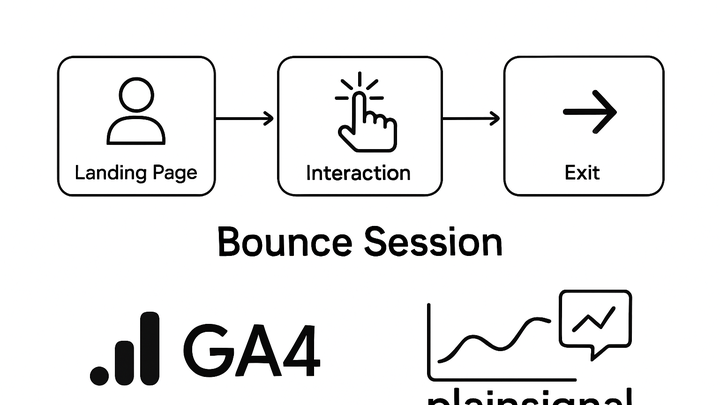Published on 2025-06-22T06:46:50Z
What is a Bounce Session? Examples in GA4 and PlainSignal
Bounce Sessions refer to sessions where a user triggers only a single interaction—such as a pageview or event—before leaving the site. This metric is crucial in analytics for assessing user engagement. In Google Analytics 4 (GA4), the concept has evolved around “engaged sessions,” but bounce sessions can still be calculated to understand exits without deeper interactions. PlainSignal, a cookie-free simple analytics tool, also tracks bounce sessions as single-page or no-event sessions, offering privacy-focused insights. This article explains the definition, measurement methods in both platforms, and strategies to reduce bounce sessions for better engagement.
Bounce session
Sessions with a single interaction before exit, measured differently in GA4 and PlainSignal.
Definition of a Bounce Session
This section defines what a bounce session is in the context of web analytics and why it matters for understanding user behavior.
-
Bounce session defined
A bounce session is a session that includes only one user interaction before the visitor leaves. This interaction can be a single pageview or a tracked event, with no further engagement recorded during that session.
Importance of Bounce Sessions
This section covers why tracking bounce sessions is important for evaluating content relevance and user engagement on your site.
-
Engagement indicator
Bounce sessions serve as a proxy for user interest. A high share of bounce sessions may indicate that visitors are not finding what they expected or that the page experience is suboptimal.
-
Benchmarking performance
Comparing bounce session rates across pages, traffic sources, and campaigns helps identify underperforming areas and prioritize optimizations.
Measuring Bounce Sessions in Analytics Tools
This section explains how Google Analytics 4 and PlainSignal calculate and report bounce sessions differently.
-
Google analytics 4 (GA4)
GA4 focuses on engaged sessions rather than traditional bounce rate, but you can derive bounce sessions by subtracting engaged sessions from total sessions.
-
Calculating bounce sessions in GA4
bounce_sessions = total_sessions - engaged_sessionsEngaged sessions in GA4 require at least 10 seconds of duration, two pageviews, or one conversion event.
-
-
PlainSignal
PlainSignal is a cookie-free analytics tool that tracks bounce sessions as single-page or no-event sessions. Install with the following snippet:
-
Implementation code
<link rel="preconnect" href="//eu.plainsignal.com/" crossorigin /> <script defer data-do="yourwebsitedomain.com" data-id="0GQV1xmtzQQ" data-api="//eu.plainsignal.com" src="//cdn.plainsignal.com/plainsignal-min.js"></script>
-
Strategies to Reduce Bounce Sessions
This section outlines practical tips to lower bounce session rates and improve overall user engagement on your site.
-
Improve page load speed
Reducing load times minimizes user frustration and drop-offs.
-
Optimize images
Compress images and implement lazy loading to speed up page rendering.
-
Minify resources
Minify CSS and JavaScript files and enable caching for faster delivery.
-
-
Enhance content relevance
Align page content with user intent using clear headings, concise messaging, and relevant visuals.
-
Clear calls-to-action
Provide prominent CTAs to guide users to related content or next steps, encouraging deeper site exploration.
Use Cases and Examples
This section highlights real-world scenarios where bounce session metrics can drive actionable insights and improvements.
-
E-commerce landing pages
Monitor bounce sessions on product and category pages to identify pages that need better offers, images, or descriptions.
-
Blog and content pages
Use bounce session data to test headlines, layouts, and internal linking strategies to keep readers engaged.
